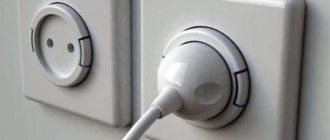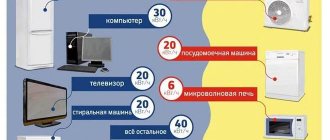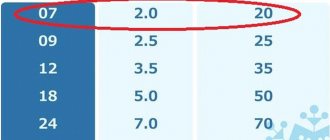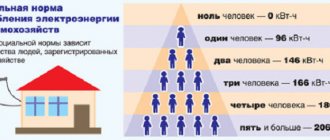Non-contractual and unmetered electricity consumption
Issues of non-contractual and unaccounted consumption of electrical energy are regulated by the “Basic Provisions for the Functioning of Retail Electricity Markets”, approved by Decree of the Government of the Russian Federation of May 4, 2012 N 442 (Section I, X) (hereinafter referred to as the Basic Provisions).
Cases of non-contractual consumption of electrical energy include:
— unauthorized connection of power receiving devices to power grid facilities;
— consumption of electrical energy in the absence of a duly concluded agreement ensuring the sale of electrical energy (power) in retail markets.
Cases of non-contractual consumption of electricity do not apply to cases of consumption of electricity in the absence of an agreement ensuring the sale of electricity (power) in retail markets within 2 months from the date established for acceptance by the supplier of last resort for servicing consumers.
Upon detection of non-contractual consumption of electrical energy, the network organization draws up a report on unaccounted consumption of electrical energy and, no later than 3 working days from the date of its preparation, sends it to the person who carried out the non-contractual consumption. Later, a calculation of the volume of non-contractual consumption of electrical energy (power) and an invoice for payment of electrical energy in the volume of non-contractual consumption are sent.
The volume of non-contractual consumption of electrical energy is determined based on the value of the permissible long-term current load of each input wire (cable) by calculation, in accordance with paragraph 2 of Appendix No. 3 to the Basic Provisions, for the period of time during which the non-contractual consumption of electrical energy was carried out, but no more than in 3 years.
In this case, the period of time during which non-contractual consumption of electrical energy was carried out in the form of unauthorized connection of power receiving devices to electrical grid facilities is determined from the date of the previous control check of the technical condition of electrical grid facilities in the place where the fact of non-contractual consumption of electrical energy was later revealed, until the date identifying the fact of non-contractual consumption and drawing up a report on unaccounted consumption of electrical energy.
The cost of electrical energy in the volume of non-contractual consumption determined in accordance with this paragraph is determined based on the prices (tariffs) specified in Section IV of the Basic Provisions.
A person who has carried out non-contractual consumption is obliged to pay an invoice to pay the cost of electrical energy in the amount of non-contractual consumption within 10 days from the date of receipt of the invoice (clause 196 of the Basic Provisions).
Cases of unaccounted consumption of electrical energy include:
facts of consumption of electrical energy in violation of the terms of the energy supply contract (purchase and sale (supply) of electrical energy (power), contract for the provision of services for the transmission of electrical energy) and the Basic provisions of the procedure for accounting for electrical energy on the part of the consumer (buyer), expressed in the following:
- interference with the operation of a metering device (metering system), the responsibility for ensuring the integrity and safety of which is assigned to the consumer (buyer), including violation (damage) of seals and (or) visual control signs applied to the metering device ( accounting system);
— failure to comply with the deadlines established by the contract for notification of the loss (malfunction) of a metering device (metering system);
— commission by the consumer (buyer) of other actions (inactions) that led to distortion of data on the volume of electrical energy (power) consumption.
The fact of unmetered consumption of electrical energy can be detected, including during an inspection of the condition of metering devices, as well as during an inspection of the metering device before its dismantling.
Upon detection of unaccounted consumption of electrical energy, the network organization draws up a report on unaccounted consumption of electrical energy and, no later than 3 working days from the date of its preparation, sends it to the person who carried out the unaccounted consumption.
The volume of unmetered consumption of electrical energy is determined using the calculation method provided for in subparagraph “a” of paragraph 1 of Appendix No. 3 to the Main Annexes. The volume of unaccounted consumption of electrical energy (power) is determined from the date of the previous control check of the metering device until the date of detection of the fact of unaccounted consumption of electrical energy (power) and drawing up a report on unaccounted consumption of electrical energy. If such an inspection was not carried out within the planned time frame, it is determined from the date no later than which it should have been carried out in accordance with the Basic Provisions.
The cost of electrical energy in the volume of unaccounted consumption is included by the guaranteeing supplier (energy sales, energy supply organization) in the invoice issued to the consumer (buyer) for payment of the cost of electrical energy (power) purchased under an agreement ensuring the sale of electrical energy (power) for that billing period, in in which the fact of unaccounted consumption was identified and a report on unaccounted consumption of electrical energy was drawn up and sent to the consumer.
The consumer (buyer) is obliged to pay the specified invoice within the period specified in the agreement ensuring the sale of electrical energy (power).
From the date of drawing up the act on unaccounted consumption of electrical energy, the volume of consumption of electrical energy (power) and the volume of services provided for the transmission of electrical energy are determined in the manner prescribed by the requirements of paragraph 166 of the Basic Provisions for calculating the volume of consumption of electrical energy (power) and services provided for the transmission of electrical energy for the case of failure to provide meter readings within the established time frame starting from the 3rd billing period.
The document recording the unaccounted, non-contractual consumption of electrical energy (power) is the act of unaccounted for electricity consumption. The requirements for this act are established by paragraph 193 of the Basic Provisions.
The act on unaccounted consumption of electrical energy must contain the following data:
— about a person carrying out unmetered or non-contractual consumption of electrical energy;
— on the method and place of unaccounted or non-contractual consumption of electrical energy;
— about metering devices at the time of drawing up the report;
- on the date of the previous inspection of metering devices - in case of detection of unmetered consumption, the date of the previous inspection of the technical condition of electric grid facilities in the place where non-contractual consumption of electrical energy was detected - in case of detection of non-contractual consumption;
— explanations of the person carrying out unmetered or non-contractual consumption of electrical energy regarding the identified fact;
— comments on the drawn up act (if any).
When drawing up an act on unaccounted consumption of electrical energy, the consumer who carries out the unaccounted consumption (the guaranteeing supplier serving him (energy sales, energy supply organization)) or the person who carries out the non-contractual consumption of electrical energy must be present.
The refusal of a person carrying out unaccounted or non-contractual consumption of electrical energy to sign the drawn up act on unaccounted for unaccounted consumption of electrical energy, as well as his refusal to be present when drawing up the act must be recorded, indicating the reasons for such refusal, in the act of unaccounted for consumption of electrical energy, drawn up in the presence of 2 disinterested persons
How to calculate electricity consumption for an apartment owner: 3 ways
I show 3 calculation technologies in order of complexity
The simplest method is an electric meter
The main role in electricity metering is played by the electric meter. It constantly converts the current flowing through it and the applied voltage into power, displaying them in an easy-to-read form.
Older induction meters use an electromechanical drive that operates by rotating an aluminum disk.
It has a rather vulnerable design from the point of view of electricity theft. It is attractive to dishonest people because it allows you to stop the counter or even make it rotate in the opposite direction in a fairly large number of ways.
In addition, their accuracy class is usually 2.5, which in some cases makes the calculation rougher.
Therefore, the induction meter is now being widely replaced by modern electronic devices that have increased protection against energy theft with many functions.
Any electric meter shows the consumption of electrical energy passing through it continuously from the moment of its installation. In order to find out the consumption for a certain period of time, for example, an hour, a day, a month, it is necessary to take its current and previous readings.
Then the value of the previous measurement is subtracted from the total operating time and the consumption is judged from the resulting difference.
When taking readings, pay attention to the last right digit. In most models it is a tenth of a kilowatt and is not used in calculations for paying for electricity; it is rounded up.
In order to avoid mistakes, it is shown in a separate window, highlighted in red or indicated in another way.
However, the meter, like a metering device, stands at the input and automatically adds up all the loads that flow through it.
The owner often needs to analyze the consumption of a single electrical appliance, which is inconvenient to do using a meter. To do this, it is necessary to completely de-energize all other consumers for a certain time and check the operation of only the one that interests you.
This is not the way to do it: there are simpler ways.
How to calculate electricity consumption based on consumer electrical values
The energy consumed by household appliances is related by formulas to:
- the amount of current passing through them to perform work;
- the value of the applied voltage;
- power;
- period of working time.
The electrician’s cheat sheet, as a generalized formula, helps to remember these characteristics and their relationships.
The first three parameters are usually indicated in the technical data sheet of the device and on its body: all or selectively.
To calculate consumption and pay for money, certain features must be taken into account. I look at them below.
Consumer voltage
In a modern apartment, 220 volts 50 hertz alternating current is usually used, and household appliances can operate on other quantities, including direct voltage. These are computers, video equipment, communications, digital equipment...
For them, special converters and power supplies are used, which also consume energy, which must be taken into account in the complex.
Load current
It is usually indicated for powerful consumers in amperes in order to accurately take into account and distribute the load on the wiring, select current protection settings, and connect electrical appliances to socket groups.
Based on current and voltage, the load can be easily converted into watts and kilowatts using an electrician’s cheat sheet.
Electrical appliance power
Here you need to be careful about the notation. Manufacturers use two types of display of device power consumption:
- active component, indicated in watts or kilowatts (W, W, kW, KW);
- the full value shown in volt-amperes (VA, VA).
The difference between them is covered in more detail in a separate article. Here you need to understand that the meter in household wiring measures the active power, and it is less than the total power by the reactive component.
Moreover, the latter quantity can be inductive, created by the operation of transformers, chokes, electric motors, or capacitive, formed by the flow of alternating current through capacitors and, for example, long cable lines.
Reactive power adds load to the wiring, but it is not taken into account by household meters. In other words: they don’t pay money for it.
Example: calculation of electricity consumption by power
Let’s say that two students rent a one-room apartment and use the same 2.1 kW electric kettle every day four times a day for 5 minutes (5∙4=20 min=1/3 hour).
In addition, the first student uses a computer with a consumption of 400 watts and 4 incandescent lamps of 60 watts each day for 4 hours.
The second apartment uses an 80-watt laptop and also 4 lamps, but LED lamps with a consumption of 8 watts each.
We first calculate the expense, and then the money for the day, week and month in the summary table.
Electrical characteristics
| Options | Apartment No. 1 | Apartment No. 2 |
| Power consumption per kettle per day | 2100(W)∙1/3(hour)=700W/h | 2100(W)∙1/3(hour)=700W/h |
| Lighting | 4∙4∙60=960W/h | 4∙4∙8=128W/h |
| Computer | 400∙4=1600W/h | 4∙80=320W/h |
| Total energy consumption per day | 700+960+1600=3260W/h | 700+128+320=1148W/h |
| Convert to kW/h | 3260W/h=3.26kW/h | 1148W/h=1.148kW/h |
Calculation of the cost of using electricity at a price of 4 rubles per kilowatt
| Fee per day | 4r∙3.26=13.04r | 4r∙1.148=4.592r |
| Pay per week | 13.04∙7=91.28r | 4,592∙7=32,144r |
| Monthly fee | 13.04∙30=391.2r | 4.592∙30=137.76 rub |
The table showed that a simple transition to energy-saving technologies can reduce the cost of payment by half.
However, this method is approximate and indicative. Real measurements provide more accurate results.
Modern energy consumption measuring devices for home use
Nowadays there are special devices on sale: household wattmeters, which are inserted into a regular outlet.
They may show:
- current power value at a given time or for a certain period;
- the magnitude of current and voltage;
- calculation of consumption at the entered tariff.
Such a measurement can be useful when checking the operation of newly purchased equipment to monitor its loads in different modes or analyze the consumption of one operating cycle.
The owner of the video “Shopping in a teahouse” showed a full overview of the functionality of this device in his video. He demonstrates the accuracy test of the device and explains the rules for communicating with it in the form of instructions.
When you don’t have such a wattmeter on hand, and the issue of checking the electrical consumer is urgent, you can get by with a simple digital multimeter. To do this, first switch it to voltmeter mode and measure the voltage.
The second step is to measure the current in the load circuit.
The third stage is calculating power by current and voltage using the previously described method.











